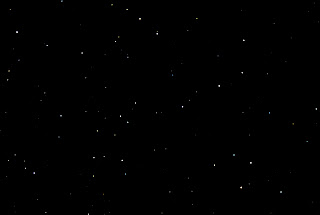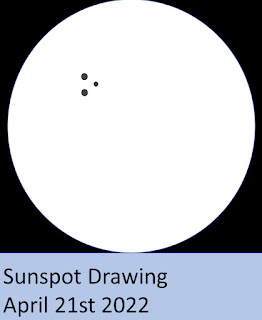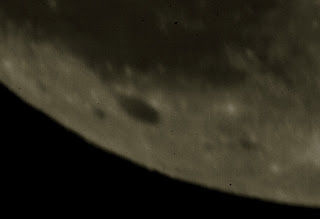April 30th 0920 GMT Sun
April 29th Flying Hockey Stick Reprocess
April 29th 2050 GMT Meteor Hunt
It was not perfectly clear, nor was it completely dark. With the sky expected to clear later, I set my camera with my brand new intervalometer at the usual settings. While our dogs were outside, I had a look in the direction of Lyra. Although there was haze, I could see Vega, Deneb and parts of Draco. I did not see any meteors, so came back inside, more in hope than expectancy.
One of the by-products of my meteor searches is a set of constellation photos. I stacked a few early frames to catch Ursa Minor and parts of Draco, including the head.
At 2130 GMT, I struck gold with a Lyrid meteor near the Dragonhead.
I tried another few frames of Ursa Minor and the Dragonhead and thought this was slightly better.
I caught two meteors in the same frame, a few seconds later but processed them separately, as they had short trails.
At 2311 GMT (Saturday 30th but still the same session) I went out to reset the camera and saw what looked like a very bright comet or galaxy above our house. I had no idea what it was but it started to move. I did not have time to reset the camera before it went out of view. The long exposure showed a short but bright trail and I caught two images. The blue colour was not noticeable to the unaided eye.
I stacked a few frames to catch Lyra and Hercules.
The final few frames were similar but showed a little bit more of Cygnus.
So what I saw as a session that started off with more hope than expectancy turned out to be a real cracker. I caught meteors, a UFO and processed a few frames to produce some constellation shots. It was May 2nd before I finished processing and blogging. What a night!
April 29th 1245 GMT Sun
April 28th 1230 GMT Sun
April 26th 0655 GMT Sun
I bin scanned the Sun and saw that the sunspots had rotated since my last view. A small one had rotated on.April 24th Morning: Sun
to catch glimpses of the Sun through thick cloud. I was able to see all but the
fainter of the sunspots I had seen the evening before. I was not able to see
the sunspots long enough to record the pattern on paper.
I captured the main sunspots but did not nail the focus.
April 23rd 1655 GMT Sun
April 23rd Morning: Gear Upgrades
April 18th 2310 GMT Moon
My long-awaited return to telescopic
photography finally arrived. I took some shots of the Moon with my Mak and DSLR
at 1.54m focal length, ISO 100 and 1/500 second exposure.
For processing, instead of stacking lots of frames, I kept varying the focus to select the best one and processed the single frame.
I then took some shots of objects of interest at 4.62m focal length, ISO 100 and 1/50 second exposure. I did not go to any longer focal length, as the lunar disc was shimmering and I would not get a steady image.
April 17th 1000 GMT Sun
With my 70mm binoculars having failed to
detect a single sunspot, I needed something with a bit more aperture.
It was a long bank holiday weekend, so I
had no rush, so I unpacked both of my Skywatcher telescopes, my ST80 and 127mm
Mak.
I still needed to make a new filter for
my Mak but had a half-decent one that fitted my ST80. Visually, I detected two
sunspots and made a drawing. My focusser needed some attention. It was OK-ish
for visual use but useless for photography.
April 16th 2220 GMT Moon
April 16th 0045 GMT Moon
The Moon was about 18 hours before its
full phase. With only brighter stars visible in the bright moonlight, neither
deep sky nor constellation photos were possible.
I had another go at the Moon, less than
four hours after my last photo and used the same camera settings.
April 15th 2100 GMT Moon
I snapped the Moon at 300mm focal length,
ISO 100 and 1/2000 second exposure.
April 14th 2100 GMT Moon
There was a lot of cloud and haze around
but I proceeded with a lunar photo shoot with my DSLR at 300mm focal length,
ISO 100 and 1/2000 exposure.
April 13th 2050 GMT Moon and Betelguese
I snapped the waxing gibbous moon at
300mm focal length, ISO 100 and 1/1600 second exposure.
Meanwhile, Betelguese appeared brighter
than Procyon, despite being lower in the sky. This suggested a magnitude of
0.3, quite different to a mere two days ago.
April 11th 2040 GMT Moon
There was some haze around but I snapped the Moon with my
DSLR at 300mm focal length, ISO100 and 1/1000 second exposure.
April 9th 2100 GMT Moon and Betelguese
The first quarter moon was high in the
west, close to Castor in Gemini. I snapped it with my DSLR at 300mm focal
length, ISO 100 and 1/800 second exposure.
I saw Betelguese, Aldebaran and Procyon. As there was some light cloud around, the estimate was far from reliable but I guessed that Betelguese was about magnitude 0.5.
April 8th 2100 GMT Moon
I snapped the Moon with my DSLR at 300mm focal length, ISO 100 and 1/640 second.
April 7th 1920 GMT Moon
April 7th 1100 GMT Sun
The weather was quite difficult, with a lot of moving cloud but I managed to see the large sunspot about to rotate off.
April 5th 1100 GMT Sun
April 3rd 1920 GMT Moon
The Moon was two days past new and
surprisingly high in the west.
I reprocessed another frame and this came out somewhat better.
April 3rd 1000 GMT Sun
April 2nd 2125 GMT Deep Sky
April 2nd 2030 GMT Betelguese
April 2nd 1010 GMT Sun
April 1st 1100 GMT Sun
There was a lot of moving cloud but
enough clear sky to catch some sunspots.





















































No comments:
Post a Comment